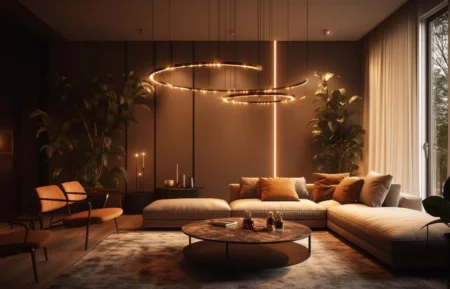 Achieving the perfect lighting in your home goes beyond functionality – it’s an art form. Designing a well-lit space involves a thoughtful blend of ambient, task, and accent lighting.
Achieving the perfect lighting in your home goes beyond functionality – it’s an art form. Designing a well-lit space involves a thoughtful blend of ambient, task, and accent lighting.
Lighting your home like a designer involves a thoughtful approach to layering, fixture selection, height variation, dimmers, architectural highlights, color temperature, and the integration of natural light.
By understanding the three layers of lighting and tailoring each room’s lighting to its function, you can transform your home into a well-lit and aesthetically pleasing space.
Here’s a guide on how to light your home like a designer, with key considerations and tips.
1. Understand the Three Layers of Lighting
Designers often refer to three layers of lighting: ambient, task, and accent lighting. Ambient provides overall illumination, task lighting serves specific functions like reading or cooking, and accent lighting highlights focal points or adds visual interest. Balancing these layers creates a dynamic and well-lit space.
2. Consider the Function of Each Room
Every room serves a different purpose, and the lighting should reflect that. In kitchens, prioritize task lighting over the countertops and cooking areas. In living rooms, focus on creating a comfortable ambiance with a mix of ambient and accent lighting. Tailor the lighting to enhance the function of each space.
3. Play with Different Light Fixtures
Light fixtures are more than just functional; they’re design elements. Experiment with a variety of fixtures, from pendant lights and chandeliers to wall sconces and floor lamps. Mixing different types of fixtures adds visual interest and allows you to customize the lighting experience.
4. Layer Lighting at Different Heights
Varying the height of your light sources contributes to a dynamic and visually appealing lighting design. Consider table lamps, floor lamps, and pendant lights to create layers at different heights, preventing a flat and uninspiring lighting scheme.
5. Use Dimmers for Versatility
Dimmer switches are a designer’s secret weapon. They provide flexibility in adjusting the intensity of the light, allowing you to create different moods and atmospheres. Install dimmers for ambient and accent lighting to achieve versatility in your home’s lighting design.
6. Highlight Architectural Features
Architectural features, such as exposed beams, alcoves, or artwork, can be emphasized with strategic lighting. Use spotlights or adjustable fixtures to draw attention to these elements, adding depth and character to your space.
7. Pay Attention to Color Temperature
The color temperature of light can significantly impact the mood of a room. Warmer tones (yellow and amber) create a cozy atmosphere, while cooler tones (blue and white) lend a more modern and vibrant feel. Match the color temperature to the room’s function and desired ambiance.
8. Layer with Natural Light
Don’t forget about natural light. Use curtains or blinds to control the amount of sunlight entering the room, and complement it with artificial lighting as needed. The interplay of natural and artificial light enhances the overall design.
Picture Credit: Freepik



